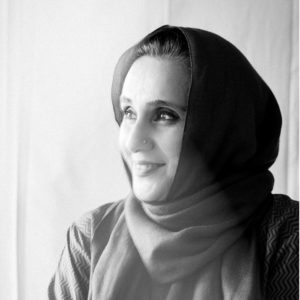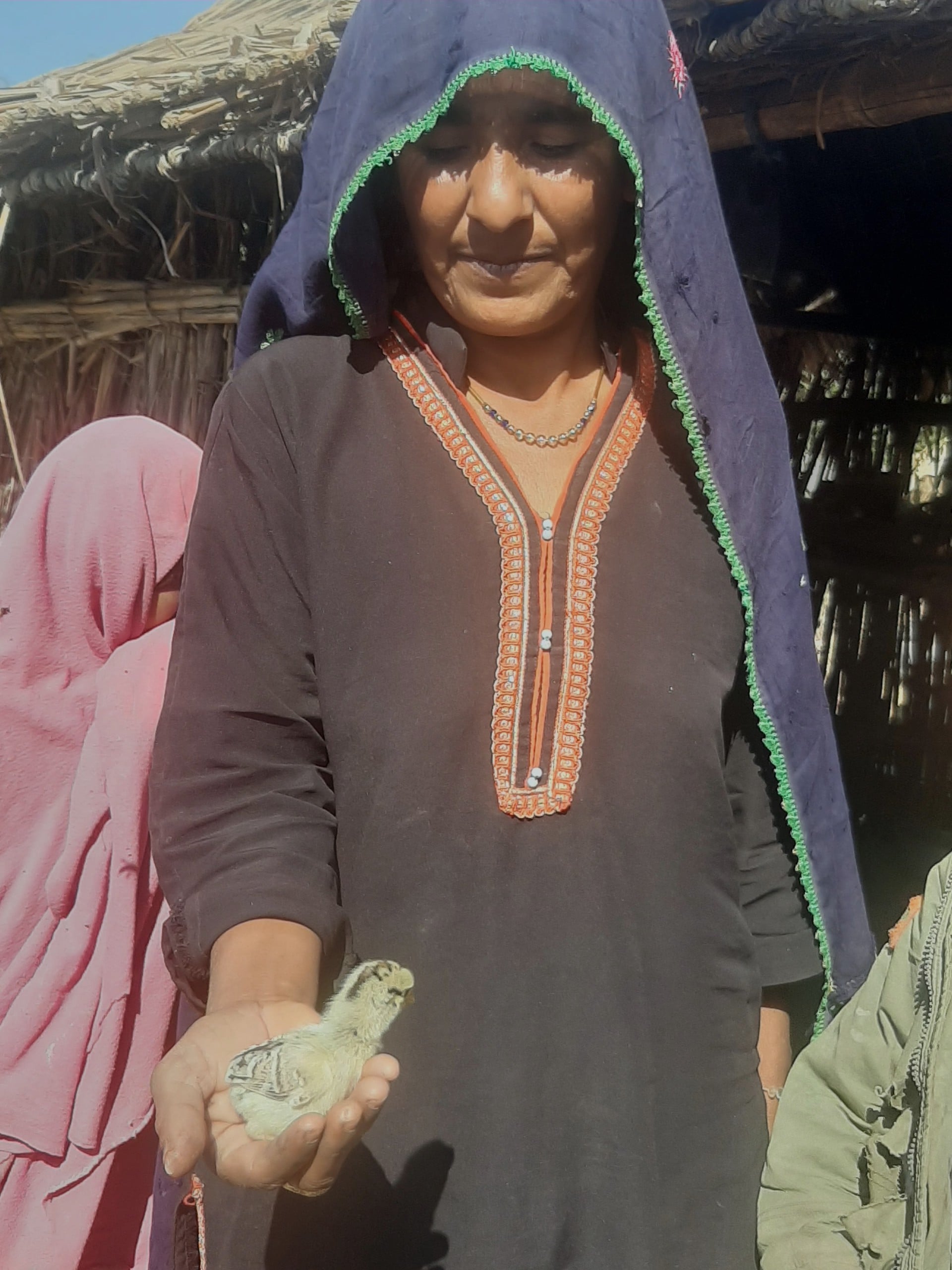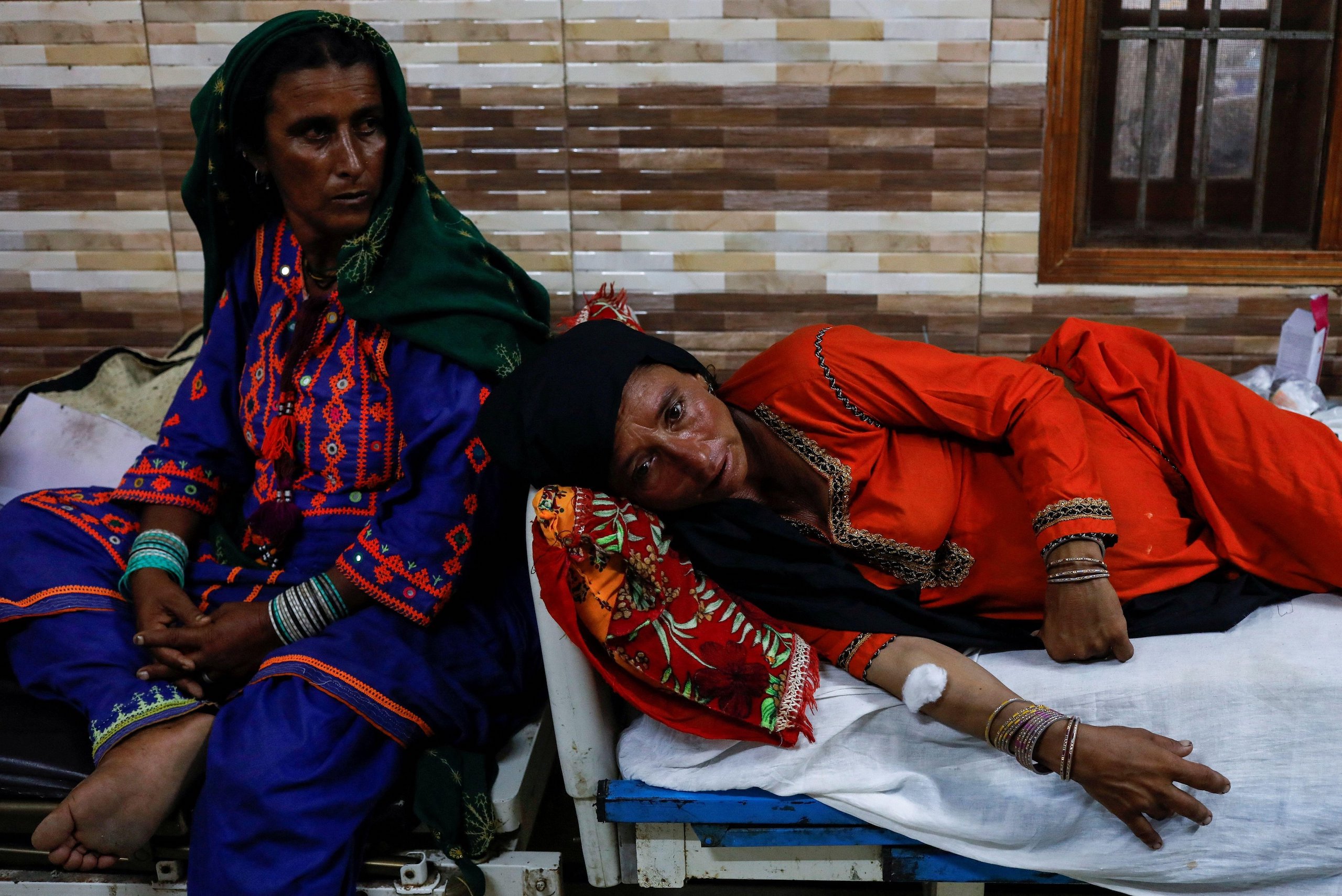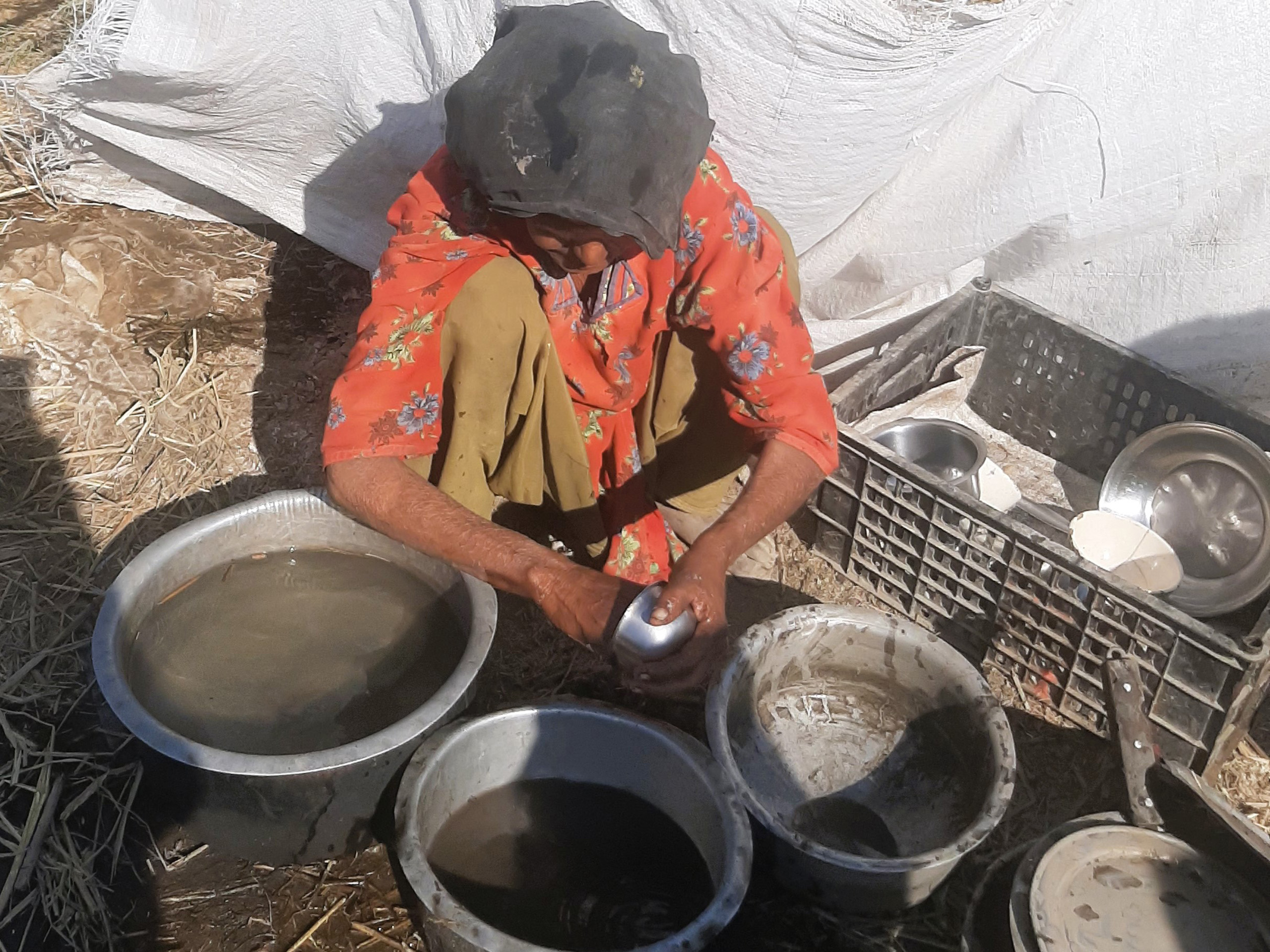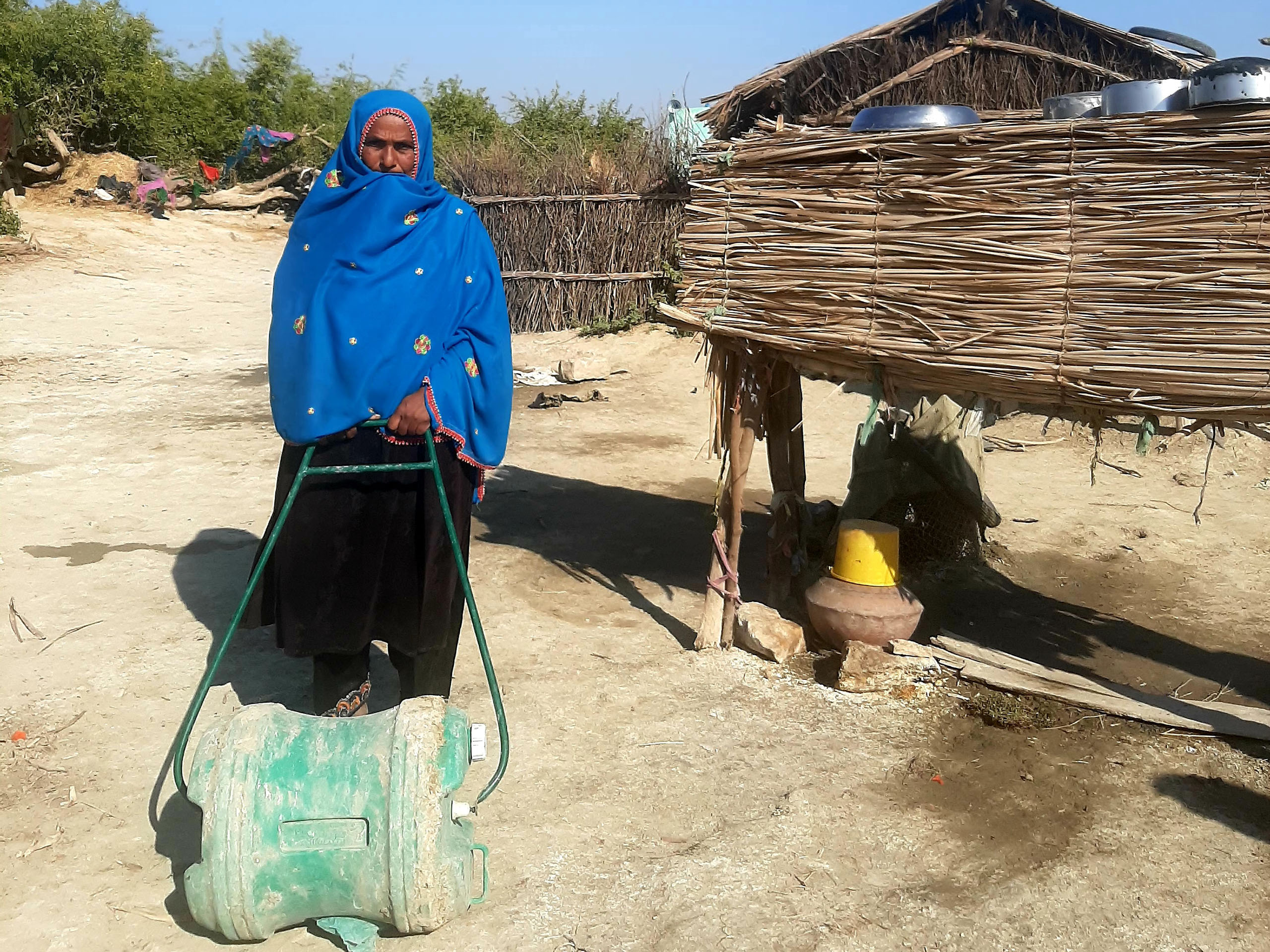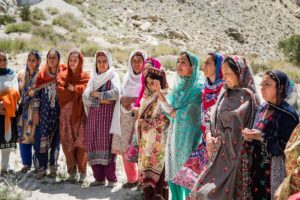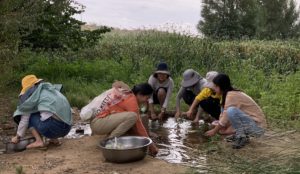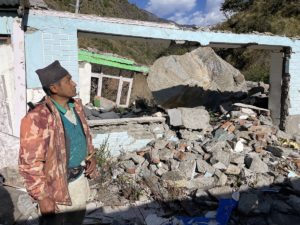Panahi welcomes visitors warmly into the dwelling she now calls home: a bare structure with a mud floor and thatched roof, through which sunlight is streaming in. There are no chairs or charpoys (traditional woven beds). A jerrycan for carrying water, a couple of bedsheets, a few utensils and a prayer mat are all the belongings her family has left.
“The floods swept everything away; we had to move to Thatta district for more than two months, empty-handed. Thank God we are back home,” says Panahi.
Panahi lives in Goth Ali Muhammad Soomro, a village of about 30 households in southern Pakistan’s Sindh province. In August last year, during the disastrous monsoon floods, Panahi’s house was swept away. Where she lives now is at best a makeshift shelter from the elements.
The family’s crops were also lost to the floods, and bones show through the hides of the few surviving cows and buffaloes in the village. Panahi’s family are surviving by raising poultry. “We don’t get to eat the eggs ourselves though – we sell them to buy flour for roti,” she says.
More than six months on from the “monster monsoon” that affected one in seven people in Pakistan and displaced nearly 8 million, the impacts of the floods are no longer making headlines. Yet in Sindh province alone, more than 89,000 people were still registered as displaced at the beginning of 2023, according to the Provincial Disaster Management Authority. The floods came on the heels of a severe and prolonged heatwave, which started earlier in the year than usual.
Experts say that women, especially those of childbearing age, were severely affected by the consecutive disasters.
Gender norms and poverty increase women’s vulnerability
“Men and women are impacted differently by climate disasters such as floods,” says Sajida Taj, a social scientist who specialises in gender and community development, and is a programme leader at the Pakistan Agricultural Research Council. “Gender norms in our society are a major reason. Gender roles are clearly divided, especially in rural settings where women are responsible for household chores, childcare and caring for the elderly.” In rural communities, while men “mostly just take care of the things outside the house,” women “cook, clean, wash clothes, prepare fodder for the livestock, milk cows and work as farm labour,” adds Abdullah Rajpar, general manager of programmes at the Indus Earth Trust, a non-profit working on sustainable development in Pakistan.
Poverty means that women are more likely to be malnourished, Rajpur explains, so that “when a disaster hits, they are hit worse. When the floodwaters start, they somehow take the mothers-in-law, the children and the cattle to higher ground. They themselves are the least of their priorities.”
Aisha Khan, head of the Mountain and Glacier Protection Organization and Civil Society Coalition for Climate Change, points out that women constitute 49% of the population “but do not have equal access to resources or opportunities”.
“This inequality contributes to their vulnerability,” says Khan.
780,000
Approximate number of homes destroyed during the 2022 Pakistan floods, with more than 1.27 million houses partially damaged
The orange-stained lips of the men, women and even children in Goth Ali Muhammad Soomro village are a tell-tale sign of this. They chew gutka, a type of tobacco product consumed across South Asia, but traditionally solely by men. “They use gutka to curb hunger as there is just not enough food,” says Rajpar. “Entire families use it. Food shortage and lack of work after the floods has made it worse. On top of this, women have to keep giving birth despite being anaemic and weak.”
Reproductive health suffers after the 2022 floods
In August 2022, the United Nations Population Fund estimated that there were 650,000 pregnant women in the flood-affected areas of Pakistan. At that point, the disaster had partially damaged or destroyed more than 1,000 health facilities in Sindh and 198 in southwest Pakistan’s Balochistan province – a situation that worsened in the following months.
“Women who are pregnant or breastfeeding face multiple challenges [during disasters],” says Tania Humayun, programme manager of the Gender and Child Cell at Pakistan’s National Disaster Management Authority (NDMA). “Their nutritional needs are not met. They’re used to living in an environment, and being displaced is not easy. They are already underprivileged. On top of this, women’s livestock and kitchen gardens are destroyed.”
In Goth Ali Muhammad Soomro, The Third Pole hears how difficult it became for pregnant women to access healthcare last year. One woman, Saima, went into labour during the floods and lost her baby. “The nearest clinic is hours away by foot, but the roads were flooded,” says Sajida, a neighbour. “With great difficulty we hired a van. It took us to a drop-off point. There onwards, the men accompanying us had to carry Saima. But by the time we reached the clinic, it was too late.”
Noreen was luckier. “This is my Gulmina; she was born during the floods,” she says. “I have eight children. Four girls and four boys.”
With thousands of kilometres of roads rendered unusable and health facilities damaged or destroyed, access to contraceptives also became more difficult. A report published last month by the Human Rights Commission of Pakistan said that while clinics were set up in relief camps, “traditional cultural barriers created the biggest hurdle in allowing these women access to reproductive help. Many women reported feeling an acute sense of loss of dignity, given the unavoidable proximity to strangers, when needing to access reproductive healthcare.”
Existing barriers to human rights compounded by disasters
Flood victims are eligible for subsidised food rations, but only on production of a National Identity Card (NIC). In many families in rural Pakistan, men get their NICs first, and women can be left without one. The risk of harassment often restricts women’s mobility and means they cannot travel alone, so they may not be able to get to where rations are distributed.
In Goth Ali Muhammad Soomro village, The Third Pole meets a 10-year-old girl carrying water in a small pot, who is too shy to give her name. Sajida speaks for her: “This girl is the second of seven siblings. Her father died in a car accident. She looks after all her siblings, washes dishes and clothes, and must make many trips to the closest water pump to fetch water. Having no male family member is a challenge in itself.” Asked why the girl does not fetch more water in one go, Sajida explains that the family does not have a jerrycan anymore. “These pots are all they have.”
Access to sanitation remains an issue, especially in the relief camps. Humayun, from the NDMA, remembers: “In Swat in 2009, women in Jalozai camp did not use restrooms all day, but long queues would form in the evening. We found out that helicopters flew overhead, and the restrooms were without roofs, so women avoided using them during the day. A lot of women faced urinary tract infections. This was taken into account when the camps were set up this time.”
The World Bank has said that children’s education, particularly girls’, is at risk in the aftermath of the disaster. Humayun knows of child marriages happening in flood-affected areas of rural Sindh. “When children are lost and found in camps, they marry them off – that is one less mouth to feed.”
On top of all this, Humayun points out, “in chaotic situations, gender-based violence increases”.
‘Transformative shift’ across society needed
Aisha Khan says patriarchal social attitudes in Pakistan need to change, and women must be factored into resilience and development plans. “It is not enough to do it on paper or make statements about gender equality. It must be seen and felt as part of a transformative shift in societal approaches that demonstrate inclusion and economic participation. Business as usual is not an option.”
A report published in September 2022 by the International Centre for Integrated Mountain Development (ICIMOD), the UN Environment Programme and UN Women stresses that understanding gender equality and social inclusion is central to understanding people’s capacities to cope with and adapt to the impacts of climate change.
Khan is clear that cultural practices, traditional values and societal constraints that lead to gender inequity must take into account the changing times and emerging threats of a warming world.
“We are not living in normal times and therefore traditional responses will not work… the sooner we make the shift the better equipped we will be to reduce vulnerability,” she says.

